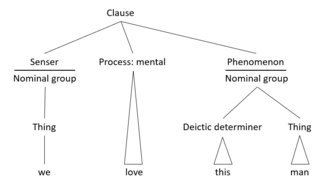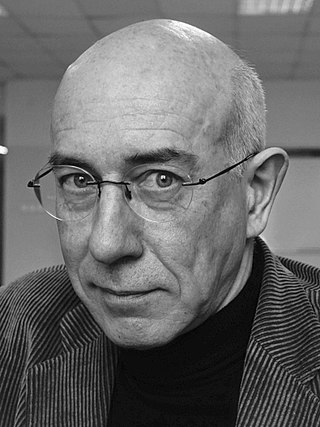Related Research Articles

Ferdinand de Saussure was a Swiss linguist, semiotician and philosopher. His ideas laid a foundation for many significant developments in both linguistics and semiotics in the 20th century. He is widely considered one of the founders of 20th-century linguistics and one of two major founders of semiotics, or semiology, as Saussure called it.

Functional linguistics is an approach to the study of language characterized by taking systematically into account the speaker's and the hearer's side, and the communicative needs of the speaker and of the given language community. Linguistic functionalism spawned in the 1920s to 1930s from Ferdinand de Saussure's systematic structuralist approach to language (1916).

Structuralism is an intellectual current and methodological approach, primarily in the social sciences, that interprets elements of human culture by way of their relationship to a broader system. It works to uncover the structural patterns that underlie all the things that humans do, think, perceive, and feel.
Theoretical linguistics is a term in linguistics which, like the related term general linguistics, can be understood in different ways. Both can be taken as a reference to theory of language, or the branch of linguistics which inquires into the nature of language and seeks to answer fundamental questions as to what language is, or what the common ground of all languages is. The goal of theoretical linguistics can also be the construction of a general theoretical framework for the description of language.
Lexical semantics, as a subfield of linguistic semantics, is the study of word meanings. It includes the study of how words structure their meaning, how they act in grammar and compositionality, and the relationships between the distinct senses and uses of a word.

Course in General Linguistics is a book compiled by Charles Bally and Albert Sechehaye from notes on lectures given by historical-comparative linguist Ferdinand de Saussure at the University of Geneva between 1906 and 1911. It was published in 1916, after Saussure's death, and is generally regarded as the starting point of structural linguistics, an approach to linguistics that was established in the first half of the 20th century by the Prague linguistic circle. One of Saussure's translators, Roy Harris, summarized Saussure's contribution to linguistics and the study of language in the following way:
Language is no longer regarded as peripheral to our grasp of the world we live in, but as central to it. Words are not mere vocal labels or communicational adjuncts superimposed upon an already given order of things. They are collective products of social interaction, essential instruments through which human beings constitute and articulate their world. This typically twentieth-century view of language has profoundly influenced developments throughout the whole range of human sciences. It is particularly marked in linguistics, philosophy, psychology, sociology and anthropology.

Dirk Geeraerts is a Belgian linguist. He is professor emeritus of theoretical linguistics at the University of Leuven, Belgium. He is the founder of the research unit Quantitative Lexicology and Variational Linguistics (QLVL). His main research interests involve the overlapping fields of lexical semantics, lexicology, and lexicography, with a theoretical focus on cognitive semantics. His involvement with cognitive linguistics dates from the 1980s, when in his PhD thesis he was one of the first in Europe to explore the possibilities of a prototype-theoretical model of categorization. As the founder of the journal Cognitive Linguistics and as the editor of the Oxford Handbook of Cognitive Linguistics, he played an instrumental role in the international expansion of cognitive linguistics. Geeraerts is one of the outspoken advocates of the implementation of empirical methodologies, such as corpus linguistics in cognitive linguistic research. He also argues for the involvement of more pragmatic elements such as contextual factors, lectal variation, and language history that influence the construal of word meanings and the choice of lexical items for concepts.
Louis Trolle Hjelmslev was a Danish linguist whose ideas formed the basis of the Copenhagen School of linguistics. Born into an academic family, Hjelmslev studied comparative linguistics in Copenhagen, Prague and Paris. In 1931, he founded the Cercle Linguistique de Copenhague. Together with Hans Jørgen Uldall he developed a structuralist theory of language which he called glossematics, which further developed the semiotic theory of Ferdinand de Saussure. Glossematics as a theory of language is characterized by a high degree of formalism. It is interested in describing the formal and semantic characteristics of language in separation from sociology, psychology or neurobiology, and has a high degree of logical rigour. Hjelmslev regarded linguistics – or glossematics – as a formal science. He was the inventor of formal linguistics. Hjelmslev's theory became widely influential in structural and functional grammar, and in semiotics.
Algirdas Julien Greimas was a Lithuanian literary scientist who wrote most of his body of work in French while living in France. Greimas is known among other things for the Greimas Square. He is, along with Roland Barthes, considered the most prominent of the French semioticians. With his training in structural linguistics, he added to the theory of signification, plastic semiotics, and laid the foundations for the Parisian school of semiotics. Among Greimas's major contributions to semiotics are the concepts of isotopy, the actantial model, the narrative program, and the semiotics of the natural world. He also researched Lithuanian mythology and Proto-Indo-European religion, and was influential in semiotic literary criticism.
In semiotics, the value of a sign depends on its position and relations in the system of signification and upon the particular codes being used.
Glossematics is a structuralist linguistic theory proposed by Louis Hjelmslev and Hans Jørgen Uldall although the two ultimately went separate ways each with their own approach. Hjelmslev's theory, most notably, is an early mathematical methodology for the analysis of language which was subsequently incorporated into the analytical foundation of current models of functional–structural grammar such as Danish Functional Grammar, Functional Discourse Grammar and Systemic Functional Linguistics. Hjelmslev's theory likewise remains fundamental for modern semiotics.

The expression Geneva School refers to (1) a group of linguists based in Geneva who pioneered modern structural linguistics and (2) a group of literary theorists and critics working from a phenomenological perspective.
Langueandparole is a theoretical linguistic dichotomy distinguished by Ferdinand de Saussure in his Course in General Linguistics.
Structural linguistics, or structuralism, in linguistics, denotes schools or theories in which language is conceived as a self-contained, self-regulating semiotic system whose elements are defined by their relationship to other elements within the system. It is derived from the work of Swiss linguist Ferdinand de Saussure and is part of the overall approach of structuralism. Saussure's Course in General Linguistics, published posthumously in 1916, stressed examining language as a dynamic system of interconnected units. Saussure is also known for introducing several basic dimensions of semiotic analysis that are still important today. Two of these are his key methods of syntagmatic and paradigmatic analysis, which define units syntactically and lexically, respectively, according to their contrast with the other units in the system.
The Copenhagen School is a group of scholars dedicated to the study of linguistics, centered around Louis Hjelmslev (1899–1965) and the Linguistic Circle of Copenhagen, founded by him and Viggo Brøndal (1887–1942). In the mid twentieth century the Copenhagen school was one of the most important centres of linguistic structuralism together with the Geneva School and the Prague School. In the late 20th and early 21st century the Copenhagen school has turned from a purely structural approach to linguistics to a functionalist one, Danish functional linguistics, which nonetheless incorporates many insights from the founders of the Linguistic Circle of Copenhagen.
Linguistics is the scientific study of language. The modern-day scientific study of linguistics takes all aspects of language into account — i.e., the cognitive, the social, the cultural, the psychological, the environmental, the biological, the literary, the grammatical, the paleographical, and the structural.
Stratificational Linguistics, also known as Neurocognitive Linguistics (NCL) or Relational Network Theory (RNT), is an approach to linguistics advocated by Sydney Lamb that suggests language usage and production to be stratificational in nature. It regards the linguistic system of individual speakers as consisting of networks of relations which interconnect across different 'strata' or levels of language. These relational networks are hypothesized to correspond to maps of cortical columns in the human brain. Consequently, Stratificational Linguistics is related to the wider family of cognitive linguistic theories. Furthermore, as a functionalist approach to linguistics, Stratificational Linguistics shares a close relationship with Systemic Functional Linguistics (SFL).
Rasmus Viggo Brøndal was a Danish philologist and professor of Romance languages and literature at Copenhagen University.
Theory of language is a topic from philosophy of language and theoretical linguistics. It has the goal of answering the questions "What is language?"; "Why do languages have the properties they have?"; or "What is the origin of language?". In addition to these fundamental questions, the theory of language also seeks to understand how language is acquired and used by individuals and communities. This involves investigating the cognitive and neural processes involved in language processing and production, as well as the social and cultural factors that shape linguistic behavior.
Distributionalism was a general theory of language and a discovery procedure for establishing elements and structures of language based on observed usage. The purpose of distributionalism was to provide a scientific basis for syntax as independent of meaning. Zellig Harris defined 'distribution' as follows.
“The DISTRIBUTION of an element is the total of all environments in which it occurs, i.e. the sum of all the (different) positions of an element relative to the occurrence of other elements[.]”
References
- 1 2 3 Geeraerts, D. (2009) Structuralist Semantics in Geeraerts (2009) Theories of Lexical Semantics ch.2
- ↑ Rastier, F. Interpretative semantics in Riemer, N. (2015) The Routledge Handbook of Semantics, ch.29
- ↑ Rastier, F. (1987) Sémantique interprétative (3rd edition 2009)
- Peter Hugoe Matthews (23 April 2001). A Short History of Structural Linguistics. Cambridge University Press. p. 118. ISBN 978-0-521-62568-5.
- John Lyons (30 November 1995). Linguistic Semantics: An Introduction. Cambridge University Press. p. 103. ISBN 978-0-521-43877-3.